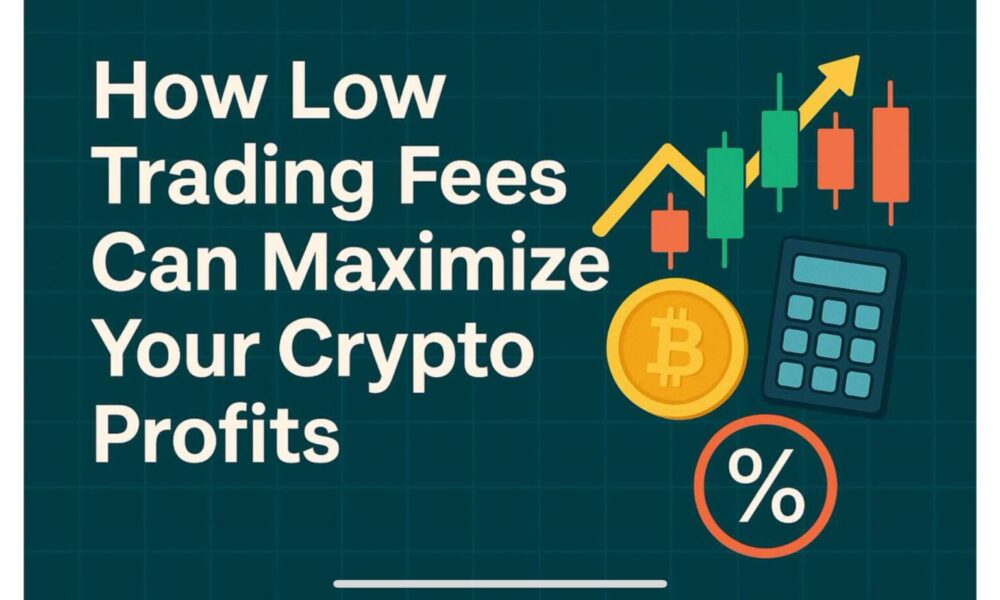How Low Trading Fees Can Maximize Your Crypto Profits

Cryptocurrency markets continues to attract participants from all walks of life each with their own goals. Some approach it with long-term investment plans, others prioritize short-term trading activity. Across styles and strategies, the trading fees domain can impact the gains of virtually anyone.
They don’t make headlines, but they influence outcomes. With each transaction, a portion of capital is redirected, not by market forces, but by the mechanics of the platform. This cost, often overlooked, steadily alters performance.
That’s where the discussion starts. Low trading fees can maximize your crypto profits by reducing the structural friction in every position. It’s not a theory. It’s arithmetic. And it applies before any trade is ever placed.
What Are Crypto Trading Fees?
In crypto trading, fees can a complex subject to touch. Most centralized exchanges apply a model where both sides of a trade, maker and taker, are charged a fee. Unlike traditional equity markets in the U.S., where market makers often receive rebates for providing liquidity, crypto uses what’s known as a take–take structure. In both cases, a percentage of the trade value is deducted.
Maker fees apply when you place a limit order that sits on the order book. Taker fees are charged when you place a market order or fill against an existing order. While some exchanges offer slightly better rates for makers, both sides still pay.
Spot trading, futures trading, and perpetual contracts all come with separate fee structures. For example, futures fees might appear lower, often 0.02% to 0.06%, but leverage amplifies the volume and, with it, the total fees paid.
Some exchanges also add funding rate mechanisms or settlement costs. These are not fixed percentages and can shift based on market conditions, affecting profitability in ways that aren’t always visible at the time of execution. Understanding how these fee models work is essential before deciding on a trading strategy or selecting which pairs to trade.
How Trading Fees Alter Strategy Mathematics
Trading fees don’t just show up as a number on the summary, they shift the entire framework of a strategy. Once a position is entered, the asset isn’t just expected to perform, it’s expected to cover the cost of participation.
If a platform charges 0.25% per side, the asset needs to move by at least 0.5% for the trade to register as even. That margin increases in volatile markets where execution isn’t precise. The more frequently a trader enters and exits positions, the more weight those figures carry.
Short-term traders are the most exposed. When movement targets are tight, a fraction of a percent in many cases, fee thresholds often overlap with expected returns. A setup that looks viable technically may, in real terms, offer no net outcome once costs are accounted for.
This isn’t exclusive to intraday activity. Swing positions that involve frequent reallocation, or systems built on multiple small gains, also feel the pressure. The core strategy might hold, but the output begins to deviate from expectations. Not because of direction, but because of how often the system resets.
Minimizing Fees Without Changing Your Strategy
So is crypto trading all about benefiting the exchange with their take–take model? There are a few ways to reduce your fees, without changing how you trade.
1. Order Type:
This is easy to spot. In most cases, maker fees are lower than taker fees, especially when trading futures. To avoid paying more, take advantage of maker orders. This naturally encourages better setups too. Instead of chasing trades on instinct, wait for the price to reach your entry level. That way, your execution is more disciplined, and you avoid unnecessary taker fees.
2. Exchange Selection:
There’s no fixed rule that says fees have to follow a standard structure. Every exchange sets its own model, some charge extremely high fees, while others qualify as the lowest fees crypto exchanges with much leaner pricing, offering spot fees as low as 0.05%. Choosing the right platform depends on your trading style; some are better for futures traders, offering lower costs on contracts and funding.
3. Exchange Incentives:
Many platforms offer discounts for holding their native token. In some cases, these discounts go up to 50%. The bonus? If the token appreciates in value, you might gain from both sides, lower trading costs and capital growth on the token itself.
Final Thoughts
Low trading fees matter because they affect more than just the immediate trade. From break-even thresholds to capital rotation, they shape how a strategy performs over time. What works in theory often delivers different results once cost layers are applied. That difference adds up, slowly, but consistently.
Fee management doesn’t require a complicated system or constant adjustment. It’s about staying aware, choosing efficient execution paths, and using platforms that don’t penalize every move. In competitive markets, low trading fees can maximize your crypto profits, not by chasing higher returns, but by keeping more of what’s already earned.

Source: How Low Trading Fees Can Maximize Your Crypto Profits



